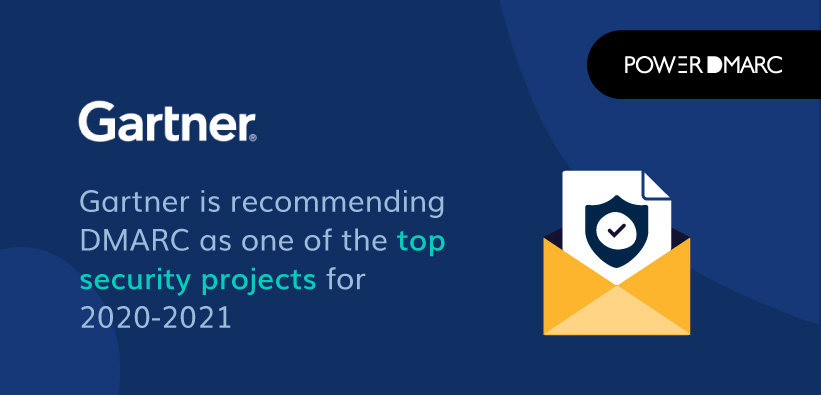When you’re in the cybersecurity space for as long as we’ve been, you start to notice patterns in how some organizations view the purpose of security. A lot of people see cybersecurity measures more as a way to meet compliance standards than to actually secure their digital processes. This is a rather myopic way of looking at it, because it fails to properly convey the real-world utility security has.
In a recent article by Gartner, they listed 10 top security projects for 2020-2021. According to security and risk management leaders, these are the most important strategies for organizations to not only mitigate the risk to their brand, but actually drive up their business value. “The key is to prioritize business enablement and reduce risk,” writes Kasey Panetta, ” and communicate those priorities effectively to the business.”
Among others, DMARC was listed as one of the most important security measures organizations can leverage for their business. So how does that work exactly? How is it supposed to improve your business value in the long run? Let’s find out.
DMARC is About More Than Just Email
Sure, if we’re going to be technical, then yes. DMARC is an email authentication protocol that helps receiving servers weed out fake email sent from your domain. But when properly implemented, DMARC is a tool brands can use to build trust, credibility and authenticity through their digital communications. It’s also a way to ensure that the brand message you’re trying to convey isn’t diluted or dampened by impersonation attempts.
It’s incredibly difficult for the average user to tell when they’re being spoofed, because of how innocuous the emails often look. They can be as simple as asking your customer to log in to your online service to update information, like these massive Office 365 phishing scams that compromised thousands of accounts. Or it could be as complex and carefully orchestrated as the Silent Starling attack of 2019.
DMARC protection isn’t just going to keep the spam email out of your customers’ inboxes. It’s how you’re going to ensure that your customers have the confidence to click on your emails when they see them. Email authentication doesn’t just bring measurable benefits like increased delivery rates, it offers real-world benefits to your brand that go beyond numbers on a graph.
5 Benefits of DMARC for Business
1. Information
This is the most tangible and measurable benefit of DMARC, and it comes in the form of DMARC reports. Once you set up DMARC, you can start receiving reports to your email about which emails failed SPF, DKIM and DMARC.
It also provides other useful information, such as the sender’s IP address, so you can see if they’re an authorized sender or not. You can see what percentage of your emails are being authenticated, which will affect deliverability, and you can check how many emails each IP sends, in case of suspicious activity.
2. Control
When you have information, you also have control. You can see if you’re having delivery issues due to DMARC, in which case you can take immediate action to rectify the problem and boost your email deliverability.
Additionally, if you spot an abusive IP spoofing your domain, you can even contact their hosting provider and have them taken down, eliminating the threat. When you have control over your communication channels, you’re also taking back control of your brand.
3. Security
This is the most obvious benefit of DMARC, since it was created with the intention of securing email senders and receivers from the dangers of phishing. With DMARC, the security benefits are twofold: both your staff and customers are protected from spam.
Attackers that impersonate your boss or CEO send phishing emails to your employees to get them to transfer money or give access to sensitive data. In other cases, they impersonate your brand and send fake emails to customers or the public.
In both scenarios, if the email comes from an unauthorized source, DMARC will identify it, and if you’re 100% DMARC enforced, the email will be automatically rejected.
4. Visibility
DMARC makes it possible to use BIMI (Brand Indicators for Message Identification). This protocol attaches your brand’s logo next to every email you send. If your email is validated by DMARC, the user will see your logo in the inbox.
This is useful for two reasons: Brand visibility, and Customer trust. Not only will users come to recognize and feel familiar with your brand after regularly seeing your logo, but they’ll know that only emails with your logo next to them are genuine.
5. Deliverability
Implementing DMARC tells your email service provider that you’re using a higher level of security than most domains. This will increase your domain’s reputation with the provider, and it will make it less likely for your genuine, authenticated emails to accidentally be marked as spam.
More emails make it to your customers’ inboxes, which means more clicks and engagement. And that never hurt, did it?
The DMARC journey is a carefully tuned process that looks at all aspects of your email usage patterns. Through careful monitoring and analysis, you can go from zero to 100% DMARC enforcement in just a couple of weeks. Here’s how it works.
Get in touch with us now to know more or start a free trial in order for us to provide you a fast track path to DMARC enforcement.
